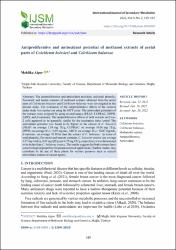Antiproliferative and antioxidant potential of methanol extracts of aerial parts of Colchicum boissieri and Colchicum balansae
Citation
Alper, M. 2022. "Antiproliferative and Antioxidant Potential of Methanol Extracts of Aerial Parts of Colchicum Boissieri and Colchicum Balansae." International Journal of Secondary Metabolite 9 (2): 149-157. doi:10.21448/ijsm.1056920.Abstract
The antiproliferative and antioxidant activities, and total phenolic, flavonoid, and tannin contents of methanol extracts obtained from the aerial parts of Colchicum boissieri and Colchicum balansae were investigated in the present study. The evaluation of the antiproliferative effects of the extracts under study was carried out using the MTT assay. The antioxidant potentials of the extracts were assigned by using several assays (FRAP, CUPRAC, DPPH, ABTS, and β-carotene). The antiproliferative effects of both extracts on Caco-2 cells appeared to be generally similar for the incubation times tested. The antioxidant potential was found to be higher in the extract of C. boissieri (FRAP: on average 1.39 mg TE/g, CUPRAC: on average 10.06 mg TE/g, DPPH: on average IC50= 0.59 mg/mL, ABTS: on average IC50= 0.267 mg/mL, β-carotene: on average 78.58%) than the extract of C. balansae. In terms of total phenolic, flavonoid and tannins contents, C. boissieri extract (on average 1.97 mg GAE/g, 8.65 mg QE/g and 4.75 mg CE/g, respectively) was determined to be richer than C. balansae extract. The results suggest that both extracts have some biological properties for pharmaceutical applications. Further studies may contribute to the use of these plants for various purposes such as natural antioxidant sources or cancer agents.


















